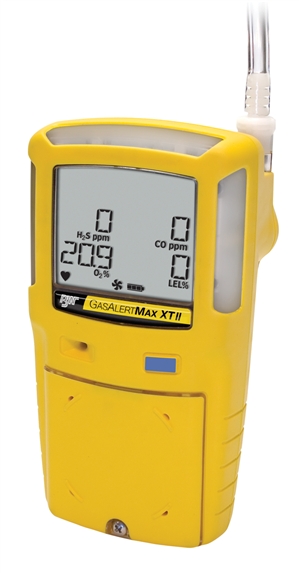Air quality testing
The air within the confined space should be tested from outside of the confined space before entry into the confined space. Care should be taken to ensure that air is tested throughout the confined space - side-to-side and top to bottom. A trained worker using detection equipment that has remote probes and sampling lines should do the air quality testing. The sampling should show that:
 The oxygen content is within safe limits - not too little and not too much.
The oxygen content is within safe limits - not too little and not too much.- A hazardous atmosphere (toxic gases, flammable atmosphere) is not present.
- Ventilation equipment is operating properly.
The results of the tests for these hazards are to be recorded on the Entry Permit along with the equipment or method(s) that were used in performing the tests.
How are hazards controlled in confined spaces?
How is air quality maintained?
Natural ventilation (natural air currents) is usually not reliable and sufficient to maintain the air quality. Mechanical ventilation (blowers, fans) is usually necessary to maintain air quality.
- If mechanical ventilation is provided, there should be a warning system in place to immediately notify the worker in the event of a hazard or a failure in the ventilation equipment.
- Care should be taken to make sure the air being provided by the ventilation system to the confined space is ’clean’.
- Ease of air movement throughout the confined space should be considered because the danger of pockets of toxic gases still remains even with the use of mechanical ventilation.
- Do not substitute oxygen for fresh air. Increasing the oxygen content will significantly increase the risk of fire and explosion.
- The use of mechanical ventilation should be noted on the entry permit.
The following paragraphs provide information on ventilation, isolation, and respirators. All these are important for air quality maintenance and the safety of workers. All these are monitored and regulated as per regulations of industrial health and hygiene.
Ventilation
Ventilation by a blower or fan may be necessary to remove harmful gases and vapors from a confined space. There are several methods for ventilating a confined space. The method and equipment chosen are dependent upon the size of the confined space openings, the gases to be exhausted (e.g., are they flammable?), and the source of makeup air.
Isolation
- Isolation of a confined space is a process where space is removed from service by:
- Locking out by electrical sources, preferably at disconnected switches remote from the equipment.
- Blanking and bleeding pneumatic and hydraulic lines.
- Disconnecting belt and chain drives, and mechanical linkages on shaft-driven equipment where possible.
- Securing mechanical moving parts within confined spaces with latches, chains, choke, blocks, or other devices.
- Locking out by electrical sources, preferably at disconnected switches remote from the equipment.
- Blanking and bleeding pneumatic and hydraulic lines.
- Disconnecting belt and chain drives, and mechanical linkages on shaft-driven equipment where possible.
- Securing mechanical moving parts within confined spaces with latches, chains, choke, blocks, or other devices.
Respirators
How are fire and explosion prevented?
Work where a flame is used or a source of ignition may be produced (hot work) should not normally be performed in a confined space unless:
- All inflammable gases, liquids, and vapors are removed prior to the start of any hot work. Mechanical ventilation is usually used to
- keep the concentration of any explosive or flammable hazardous substance
- less than 10% of its Lower Explosive Limit
- make sure that the oxygen content in the confined space is not enriched.
- Oxygen content should be less than 23% but maintained at levels greater than 18%. (These numbers can vary slightly from jurisdiction to jurisdiction.)
- Surfaces coated with combustible material should be cleaned or shielded to prevent ignition.
If potential flammable atmosphere hazards are identified during the initial testing, the confined space should be cleaned or purged and ventilated and tested again before entry to the confined space is allowed. Only after the air testing is within allowable limits entry should occur as the gases used for purging can be extremely hazardous.
How are energy sources controlled?
All potentially hazardous energy sources must be de-energized and locked out prior to entry to the confined space so that equipment cannot be turned on accidentally.
Checklist
YES | NO | |
|---|---|---|
Is entry necessary? |
YES | NO | TESTING |
|---|---|---|
Are the instruments used in atmospheric testing properly calibrated? | ||
Was the atmosphere in the confined space tested? | ||
Was Oxygen at least 19.5% - not more than 21%? | ||
Were toxic, flammable, or oxygen-displacing gases/vapors present? |
Which of the following gases are identified? | |
|---|---|
Hydrogen Sulfide | |
Carbon Monoxide | |
Methane | |
Carbon Dioxide | |
Other (list) | |


Post a Comment